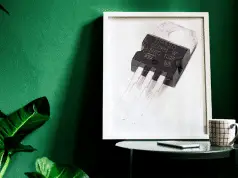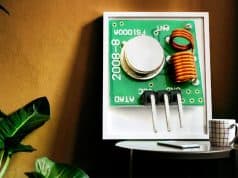Are you worried about your child getting lost while you are outside the crowded area? This is obvious, is not it? This project will reduce your child’s risk of getting lost in unknown and crowded places and will, therefore, eliminate your nightmare.
As you may have guessed from the name, this project is basically a kid tracker that gives you the exact GPS location of your phone via text message when needed.
This project uses MediaTek Linkit ONE as the basis for communication between your handset and tracker and for GPS location.
Because linkit has built-in GSM and GPS capabilities, you do not have to connect any external shields or modules, making it a perfect weekend project that can be completed in less than an hour.
You only need a SIM card with some balance or SMS package. The best part is that the device will work anywhere in the world, provided there is a mobile network there.
The item is enclosed in a digital camera bag so it can be strapped to the waist with a belt that can be kept in your child’s backpack or pocket.
Because of its GPS capabilities, you can use it not only as a child tracker but also as a car tracker or backpack anti-theft device.
This process is very simple. As you probably already know, link one as a built-in GPS and GSM feature. So when you send a message to your cell phone to link a message, it will be received by the linked SIM card and sent to the board later.
The board then processes the signal, obtains the GPS data by connecting directly to the satellite, and then sends the data to the satellite. This is mentioned in the code.
The data entered on Google Maps gives you the exact GPS location of your device. Since the device will be with your children, it will tell your child’s location so that you can easily reach that place.
Note that data can only be acquired with the device turned on. Insufficient power or insufficient battery, GPS data will not be given to you.
Note:- I have written a post for people looking for the laptop backpack for women, do read it If you are interested.
Step-by-Step Process to Build wearable tracker for kids with Arduino
STEP 1 Collect Hardware
You will need the sections and tools mentioned below to complete this project. In fact, if you already have a Linkit, you only need a SIM card and a shell on it.
1x MediaTek Linkit ONE
1 3.7v lithium battery
1x GSM antenna
1x GPS antenna
1x SIM truck (cannot be locked)
1x cabinet for your project (I use a camera bag)
STEP 2 Make Connection of Antennas
The first step is to connect the two antennas in their respective sockets. This should be easy. Find a larger yellow square antenna (GPS) and a rectangular black (GSM / GPRS) than the other black in your linkit bag.
Look for the antenna socket on the back of your circuit board. Plug in your antenna and connect to the appropriate socket marked on the board
STEP 3 Make Connection with Battery and insert the SIM CARD
The next step is to connect the battery and the SIM card. First, connect the battery to the white socket at the bottom left of the board. When setting the large switch to the BAT position, you should see the onboard LED light up.
Next, insert the SIM card into the micro SD / SIM combo slot on the circuit board. Make sure your SIM card is not locked or you will not be able to work.
STEP 4 Download and install Arduino IDE
Now, Next step in setting everything to upload the first code to the board is to install the Arduino IDE. To do this, go to the official Arduino website first. You should have 1.5.6 or later to install the SDK later. If you already have, you can skip this step. On the site, go to the previous version page and download version 1.5.6 or later.
Finally, install it on your computer. Please note that you will need to install the drive and folders later.
Note:- I have written a post for people looking for the Best Hoverboard for kids, do read it If you are interested.
STEP 5 Install the Linkit One SDK
The Arduino IDE is not enough to upload code to link a piece of code. You will need an additional IDE plug-in called Linkit, a software development kit (SDK) that makes the motherboard compatible with the IDE. Without the SDK, it will not work with Arduino Uno.
First, you need to register with the official Mediatek website to download the latest version of the SDK. After that, go to the download page and download version 1.1.17 at the top of the page.
Now open the installer and select the destination folder where you installed the IDE. After the installation process, in the last pop-up window ensure that you choose to install a linkit USB driver. Finally, click Finish, you will be done.
STEP 6 Installing Drivers
When you have finished installing the SDK, finally connect your Linkit board with a micro USB cable. The driver will be installed automatically. Make sure the small switch next to the battery connector should be set to UART and the other switch near the SPI connector to SPI.
To check the board’s COM port, go to the control panel (Windows only) and select “Devices and Printers“. Then under the COM port, you will see all the devices. Search your board. It will have two COM ports. Pay attention to both of them.
Now open the IDE. Go to Tools> Boards and select Linkit one. Then select the COM port you noted earlier in Tools> Ports. They have two. You must select the debug port instead of the modem port.
STEP 7 Combine the Hardware Together
And that’s it! You completed the architectural part of this project. The last step is to tape everything together. You can also use compression relations.
Try to keep everything in place and keep the size as small as possible by arranging batteries and antennas. Use some tape to keep everything in place. You may also need to apply some tape below the circuit board to avoid any unnecessary connection to the metal base.
LAST STEP Upload Source Code
Upload the code given right below. Before uploading, make sure that switches 1, 2, and 3 are in the UART, USB, and SPI locations respectively.
Note: Change “0123456789” to your phone number in “LSMS.beginSMS (” 0123456789 “);” line in “void setup ()”. You want to send a message.
Source code
/////////////////////////////TechincalUstaad.com ///////////////////////////
#include <LGPS.h>
#include <LGSM.h>
gpsSentenceInfoStruct info;
const char *nextToken(const char* src, char* buf)
{
int i = 0;
while(src[i] != 0 && src[i] != ‘,’)
i++;
if(buf)
{
strncpy(buf, src, i);
buf[i] = 0;
}
if(src[i])
i++;
return src+i;
}
void printGPGGA(const char* str)
{
char latitude[20];
char longitude[20];
char buf[20];
const char* p = str;
p = nextToken(p, 0); // GGA
p = nextToken(p, 0); // Time
p = nextToken(p, latitude); // Latitude
p = nextToken(p, 0); // N
p = nextToken(p, longitude); // Longitude
p = nextToken(p, 0); // E
p = nextToken(p, buf); // fix quality
if(buf[0] == ‘1’)
{
// GPS fix
p = nextToken(p, buf); // number of satellites
Serial.print(“GPS is fixed:”);
Serial.print(atoi(buf));
Serial.println(” satellite(s) found!”);
Serial.print(“Latitude:”);
Serial.println(latitude);
Serial.print(“Longitude:”);
Serial.println(longitude);
LSMS.write(“GPS is fixed:”);
LSMS.write(“Latitude:”);
LSMS.write(latitude);
LSMS.write(“Longitude:”);
LSMS.write(longitude);
LSMS.endSMS();
}
else
{
Serial.println(“GPS is not fixed yet.”);
}
}
void setup() {
Serial.begin(9600);
while(!LSMS.ready())
delay(1000);
Serial.println(“SIM ready for work!”);
LSMS.beginSMS(“0123456789”); // replace the no. to the receiver’s no.
LGPS.powerOn();
Serial.println(“GPS ready for work!”);
}
void loop() {
LGPS.getData(&info);
if(LSMS.available())
{
printGPGGA((char*)info.GPGGA);
delay(5000);
}
}
DONE !
Visit similar tutorials on Raspberry Pi
How to Build your own Super Computer with Raspberry Pi 3 Cluster
Build Super Computer with 5$ Raspberry pi zero using Cluster HAT
How to make a Raspberry Pi bitcoin mining rig



























